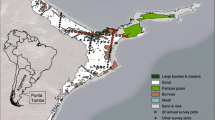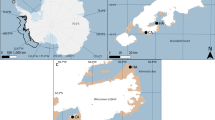Abstract
Extreme storm events encountered during any stage of the annual cycle can result in increased mortality and influence population dynamics. Storms during the reproductive season, when birds are tied to fixed nesting locations, can be particularly problematic. Given predicted changes in the frequency and intensity of storms in a changing climate, studies examining the impacts of storms on reproductive success in model systems are important. Island-nesting seabirds may be particularly vulnerable to changes in storm frequency and intensity. Here, we report on the effects of an extreme storm in June 2012 on Herring Gull (Larus argentatus) reproduction on an island in the Gulf of Maine, USA. More than 22 % of monitored nests were lost in this single event leading to a seasonal shift in the optimal nesting locations for birds in our population. Nests closer to water and nests located at low elevations were disproportionately affected by the unusual weather, reversing trends in optimal nesting sites recorded in previous seasons. Spatiotemporal shifts in optimal nesting locations, therefore, may be one result of climate-induced changes in storm frequency and intensity. Although some birds with nests destroyed in the storm attempted to renest, these attempts experienced low success, and overall reproductive success in the storm-affected season was lower than in the previous three nesting seasons.
Zusammenfassung
Veränderungen der optimalen Neststandorte durch Stürme: Ein möglicher Effekt des Klimawandels
Extreme Stürme, die irgendwann im Jahreszyklus auftreten, können zu erhöhter Mortalität führen und die Dynamik von Populationen beeinflussen. Stürme während der Brutsaison, wenn Vögel an feste Nistplätze gebunden sind, können besonders problematisch sein. In Anbetracht der vorhergesagten Veränderungen der Häufigkeit und Intensität von Stürmen im Rahmen des Klimawandels sind Studien, welche die Auswirkungen von Stürmen auf den Fortpflanzungserfolg in Modellsystemen untersuchen, besonders wichtig. Auf Inseln brütende Seevögel dürften gegenüber Veränderungen der Sturmhäufigkeit und -intensität besonders empfindlich sein. Hier berichten wir über die Effekte eines extremen Nordoststurms im Juni 2012 auf die Fortpflanzung von Silbermöwen (Larus argentatus) auf einer Insel im Golf von Maine, USA. Über 22 % der überwachten Nester wurden bei diesem Einzelereignis zerstört, wodurch es zu einer saisonalen Veränderung der optimalen Neststandorte für die Vögel in unserer Population kam. Nester, die näher am Wasser und in niedrigerer Höhe lagen, wurden vom ungewöhnlichen Wetter unverhältnismäßig stark beeinflusst, was die in vorherigen Jahren beobachteten Trends in Bezug auf optimale Neststandorte umkehrte. Raumzeitliche Verschiebungen in den optimalen Neststandorten können daher ein Ergebnis von klimainduzierten Veränderungen der Sturmhäufigkeit und -intensität sein. Einige Vögel, deren Nester durch den Sturm zerstört worden waren, versuchten, erneut zu nisten, doch diese Brutversuche waren von geringem Erfolg, und insgesamt war der Fortpflanzungserfolg in der vom Sturm betroffenen Saison niedriger als in den vorherigen drei Brutzeiten.




Similar content being viewed by others
References
Allen J, Nuechterlein G, Buitron D (2008) Weathering the storm: how wind and waves impact Western Grebe nest placement and success. Waterbirds 31:402–410
Becker P, Specht R (1991) Body mass fluctuations and mortality in Common Tern Sterna hirundo chicks dependent on weather and tide in the Wadden Sea. Ardea 79:45–55
Bergman R, Swain P, Weller M (1970) A comparative study of nesting Forster’s and black terns. Wilson Bull 82:435–444
Boe JS (1994) Nest site selection by Eared Grebes in Minnesota. Condor 96:19–35. doi:10.2307/1369060
Brown K, Morris R (1996) From tragedy to triumph: renesting in ring-billed gulls. Auk 113:23–31
Cuthbert F, Louis M (1993) The Forster’s Tern in Minnesota: status, distribution, and reproductive success. Wilson Bull 105:184–187
Davis JWF, Dunn EK (2008) Intraspecific predation and colonial breeding in lesser black-backed gulls Larus fuscus. Ibis 118:65–77. doi:10.1111/j.1474-919X.1976.tb02011.x
Easterling DR, Meehl GA, Parmesan C et al (2000) Climate extremes: observations, modeling, and impacts. Science 289:2068–2074. doi:10.1126/science.289.5487.2068
Erwin RM, Nichols JD, Eyler TB et al (1998) Modeling colony-site dynamics: a case study of Gull-billed Terns (Sterna nilotica) in coastal Virginia. Auk 115:970–978
ESRI (2010) ArcMap Release 10.0. Redlands, California, USA. Environmental Systems Research Institute
Frederiksen M, Daunt F, Harris M, Wanless S (2008) The demographic impact of extreme events: stochastic weather drives survival and population dynamics in a long-lived seabird. J Anim Ecol 77:1020–1029. doi:10.1111/j.1365-2656.2007.0
Gasparini J, Roulin A, Gill VA et al (2006) In kittiwakes food availability partially explains the seasonal decline in humoral immunocompetence. Funct Ecol 20:457–463. doi:10.1111/j.1365-2435.2006.01130.x
Götmark F, Andersson M (1984) Colonial breeding reduces nest predation in the Common Gull (Larus canus). Anim Behav 32:485–492. doi:10.1016/S0003-3472(84)80285-7
Harris MP (1964) Aspects of the breeding biology of the gulls Larus argentatus, L. fuscus and L. marinus. Ibis 106:432–456
Hatfield JS, Reynolds MH, Seavy NE, Krause CM (2012) Population dynamics of Hawaiian seabird colonies vulnerable to sea-level rise. Conserv Biol 26:667–678. doi:10.1111/j.1523-1739.2012.01853.x
Hötker H, Segebade A (2000) Effects of predation and weather on the breeding success of Avocets Recurvirostra avosetta. Bird Study 47:91–101
Jakubas D, Wojczulanis-Jakubas K (2012) Rates and consequences of relaying in Little Auks Alle alle breeding in the High Arctic an experimental study with egg removal. J Avian Biol 62–68. doi:10.1111/j.1600-048X.2012.05790.x
Jentsch A, Kreyling J, Beierkuhnlein C (2007) A new generation of climate-change experiments: events, not trends. Front Ecol Environ 5:365–374
Madeiros J, Carlile N, Priddel D (2012) Breeding biology and population increase of the Endangered Bermuda Petrel Pterodroma cahow. Bird Conserv Int 22:35–45. doi:10.1017/S0959270911000396
Montevecchi W (1978) Nest site selection and its survival value among Laughing Gulls. Behav Ecol Sociobiol 4:143–161
Morin M (1992) The breeding biology of an endangered Hawaiian honeycreeper, the Laysan Finch. Condor 94:646–667
NOAA (2012) US National Oceanographic and Atmospheric Administration, National Bouy Data Center. Station: Isles of Sholas IOSN3. http://www.ndbc.noaa.gov/station_page.php?station=iosn3
Parsons J (1975) Seasonal variation in the breeding success of the Herring Gull: an experimental approach to pre-fledging success. J Anim Ecol 44:553–573
Parsons J (1976) Factors determining the number and size of eggs laid by the Herring Gull. Condor 78:481–492
Rahmstorf S (2010) A new view on sea level rise. Nat Rep Clim Change 4:44–45. doi:10.1029/2010GL042947
Ritz MS, Hahn S, Peter HU (2005) Factors affecting chick growth in the South Polar Skua (Catharacta maccormicki): food supply, weather and hatching date. Polar Biol 29:53–60. doi:10.1007/s00300-005-0027-z
Safina C, Burger J (1985) Common Tern foraging: seasonal trends in prey fish densities and competition with bluefish. Ecology 66:1457–1463
SAS Institute (2003) SAS version 9.2. Cary, North Carolina
Sauer JR, Hines JE, Fallon JE, et al. (2013) The North American Breeding Bird Survey, Results and Analysis 1966-2011. Version 07.03.2013. In: USGS Patuxent Wildl. Res. Cent. http://www.mbr-pwrc.usgs.gov/bbs/bbs.html
Savoca MS, Bonter DN, Zuckerberg B et al (2011) Nesting density is an important factor affecting chick growth and survival in the Herring Gull. Condor 113:565–571. doi:10.1525/cond.2011.100192
Sherley RB, Ludynia K, Underhill LG et al (2011) Storms and heat limit the nest success of Bank Cormorants: implications of future climate change for a surface-nesting seabird in southern Africa. J Ornithol 153:441–455. doi:10.1007/s10336-011-0760-8
USGS (2013) National Elevation Dataset. http://ned.usgs.gov/
van de Pol M, Ens BJ, Heg D et al (2010) Do changes in the frequency, magnitude and timing of extreme climatic events threaten the population viability of coastal birds? J Appl Ecol 47:720–730. doi:10.1111/j.1365-2664.2010.01842.x
Vermeer M, Rahmstorf S (2009) Global sea level linked to global temperature. Proc Natl Acad Sci USA 106:21527–21532. doi:10.1073/pnas.0907765106
Visser ME (2008) Keeping up with a warming world; assessing the rate of adaptation to climate change. Proc R Soc Lond B 275:649–659. doi:10.1098/rspb.2007.0997
Ward P, Zahavi A (1973) The importance of certain assemblages of birds as “information-centres” for food-finding. Ibis 115:517–534. doi:10.1111/j.1474-919X.1973.tb01990.x
Wilson J, Peach W (2006) Impact of an exceptional winter flood on the population dynamics of bearded tits (Panurus biarmicus). Anim Conserv 9:463–473. doi:10.1111/j.1469-1795.2006.00063.x
Wooller R (1980) Repeat laying by kittiwakes Rissa tridactyla. Ibis 122:226–229
Acknowledgments
We thank Julie Ellis and William Clark for sharing enthusiastic support and endless knowledge of the gulls of Appledore Island. Brendan Fogarty provided field assistance. Special thanks to the staff of Shoals Marine Lab, in particular Captains Zak Robinson and Kevin Wells, for logistical support. The Cornell Lab of Ornithology’s Redhead Research Fund supported S.S.S. and M.C.M. The study was conducted in compliance with the Ornithological Council’s Guidelines to the Use of Wild Birds in Research, complied with all state and federal laws, and was approved by the Cornell University Institutional Animal Care and Use Committee (permit # 2011-0036). This is Shoals Marine Lab contribution #167.
Author information
Authors and Affiliations
Corresponding author
Rights and permissions
About this article
Cite this article
Bonter, D.N., MacLean, S.A., Shah, S.S. et al. Storm-induced shifts in optimal nesting sites: a potential effect of climate change. J Ornithol 155, 631–638 (2014). https://doi.org/10.1007/s10336-014-1045-9
Received:
Revised:
Accepted:
Published:
Issue Date:
DOI: https://doi.org/10.1007/s10336-014-1045-9




